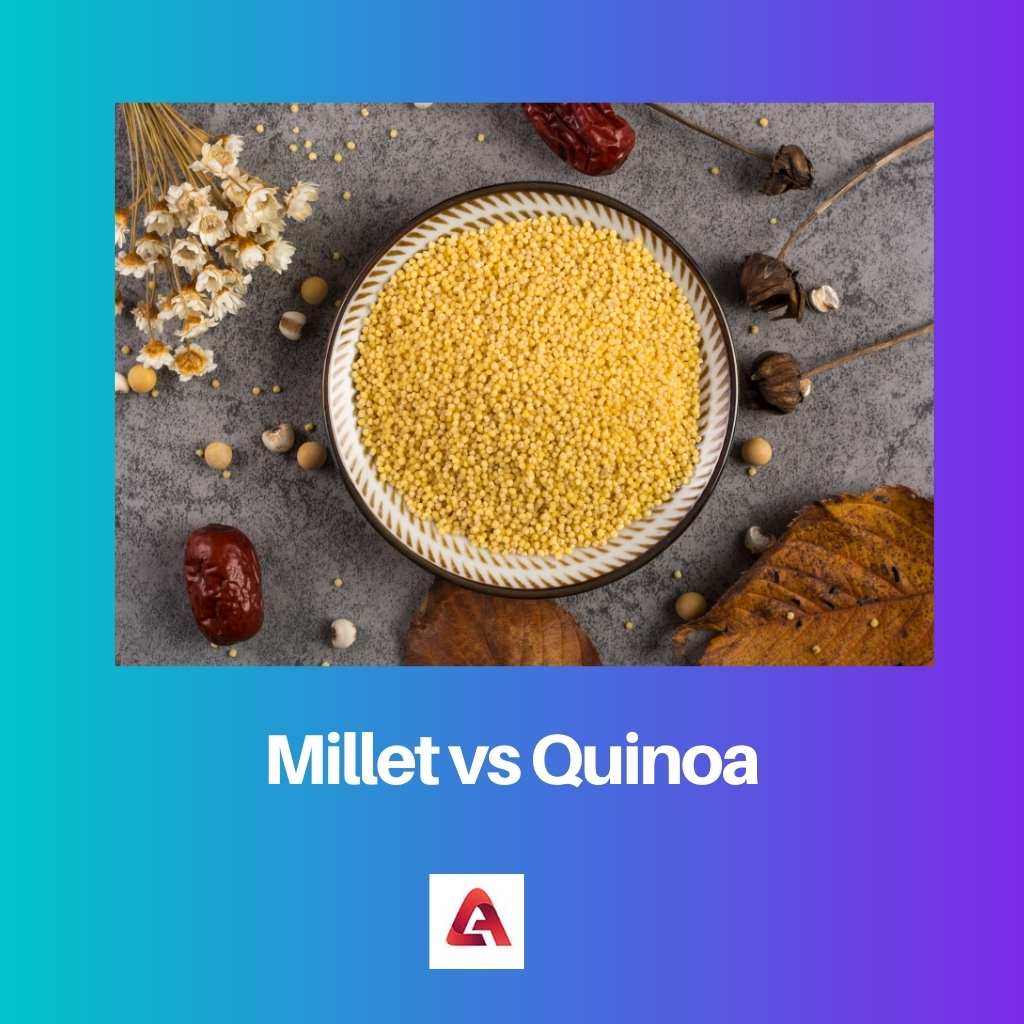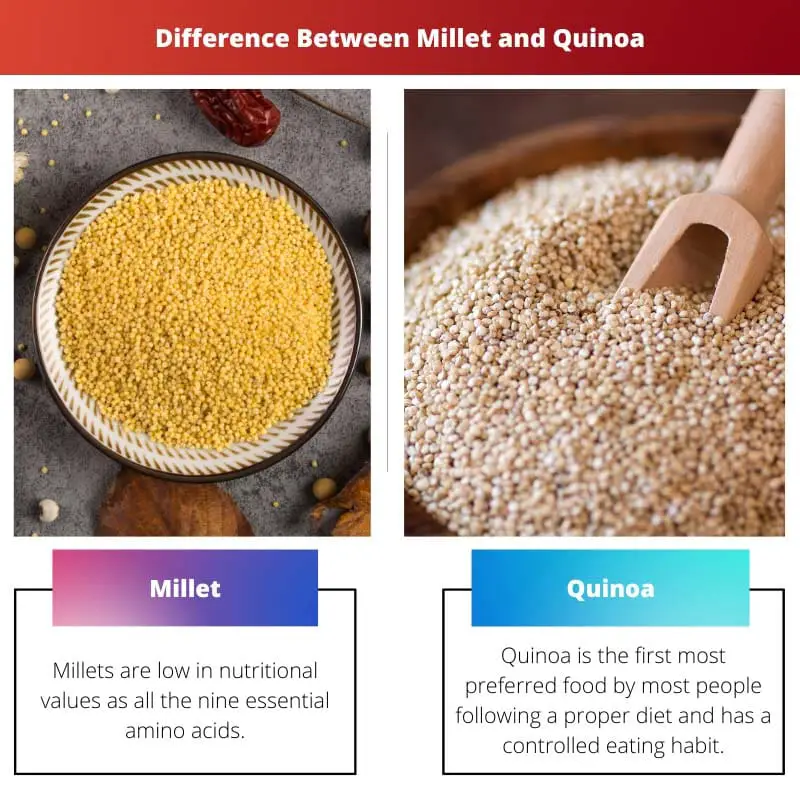Millets and quinoa are whole grains which are the go-to food for many people who are on a diet or need a low carbohydrate diet.
Unlike the refined grains that we find in the markets, whole grains like millets and quinoa contain more fiber and bran which has more nutritional value. These days, both millets and quinoa fall under the category of gourmet food.
Key Takeaways
- Millet is a small-seeded grass, whereas quinoa is a seed from the amaranth family.
- Millet contains more carbohydrates and calories than quinoa, but quinoa has a higher protein content.
- Quinoa is gluten-free and suitable for those with celiac disease, while millet is considered gluten-safe but may cause issues for some individuals.
Millet vs Quinoa
Millet is a small, round grain that is commonly grown in Africa and Asia. It is gluten-free and is used to make porridge, bread, and fermented beverages. Quinoa is a grain-like seed that is grown in South America. It is high in protein, fiber, and several vitamins and minerals.

Millets are low in nutritional values as all the nine essential amino acids that are needed by the body as the body cannot produce them are not present in it. It is more rounded with a slightly nutty taste.
There are a wide variety of millets available such as foxtail and finger millet. It is one of the best substitutes for carbohydrate-filled food for people with health issues.
Quinoa is the first most preferred food by most people following a proper diet and has a controlled eating habit. This is because quinoa is a stock of all the nine essential amino acids that are needed by our body to carry out functions.
It is used by humans alone and it is more oval.
Comparison Table
| Parameters of Comparison | Millet | Quinoa |
|---|---|---|
| Shape | Circle or spherical | Slightly oval |
| Texture | A bit grainy | Creamy |
| Vitamins Present | Vitamin B and vitamin K | Vitamin b and vitamin E |
| Expensive | No | Yes |
| Saponin Present | No | Yes |
What is Millet?
Millets are one of the most commonly used whole grains in the world and it is also accepted by many as a constant part of their diet. Being a whole grain, it has a greater amount of bran and the endosperm nutrition contained within the thin husk-like texture.
Millet is one among the many grains that are called super grains in the dietary chart. It is also gluten-free along with being a grain with high nutritional value.
One main drawback of millet is that it doesn’t have the essential amino acid called lysine which is highly valuable for the body. Therefore millet is also termed an incomplete protein element.
Other nutritional elements of millet include a high amount of vitamin B and vitamin K. Along with these vitamins, millet is also rich in multiple nutritional elements like iron and manganese.
Millets, when cooked to the right texture have a slightly nutty taste and can be a bit grainy when not chewed properly. Millets come in a huge variety of colors and with small differences in outer appearance.
Red, yellow, white, and grey are some of the colors that millets are available in. But irrespective of the outer color, millet grains do have some scars on the exterior which might look like the hilum in fruits.
Millets are one of the cheaper grains in the whole grain category and given their great nutritional value, millets are considered to be cheap.
It is important to know that millets are not used for human consumption alone as it is also used as bird feed and is also given to animals mixed with fodder. Animals are given millets as a substitute for all the nutrition they are lacking in their regular food.
Millets are a good way to control the blood sugar level and are also perfect to slow down digestion due to the high fiber content. Millets could also be dangerous when considering a few other aspects.
It contains an anti-nutrient called phytic acid which acts as a barrier when the body tries to absorb other nutrients received via other food sources.

| # | Preview | Product | |
|---|---|---|---|
| 1 |

| Anthony's Organic Hulled Millet, 3 lb, Gluten Free, Grown in the USA | Check Price on Amazon |
| 2 |

| Bob's Red Mill Millet, 28oz | Check Price on Amazon |
What is Quinoa?
Quinoa is one of the most widely recognized gourmet food that could be added to salads or eaten plain after cooking it properly. It is a whole grain that comes packed with plenty of fibers that are not processed away while packaging the grain.
The high amount of bran and endosperm in quinoa makes it ideal for people who are keenly following a proper diet and are under nutritional restraints.
Quinoa stands in the topmost position when compared to all other similar grains that are termed super grains or superfoods.
Quinoa is a storehouse of all the nine essential amino acids which the human body cannot produce and for this alone people tend to consume quinoa to meet the required amino acid quantity.
It is also highly rich in vitamin B and vitamin E, which is known as the beauty vitamin and older adults consume quinoa to maintain their skin.
All other essential elements expected to be in a superfood such as iron, magnesium, etc are also present in quinoa.
Quinoa requires to be washed thoroughly before use as there is a small layer of a chemical compound called saponin on the outer of quinoa.
This layer is what makes quinoa slightly bitter and hard to swallow. Saponin is also a toxic component that might give the user side effects such as nausea or stomachaches.
When cooked properly, quinoa has a nutty flavor which is also creamy when chewed properly. Quinoa is not just boiled and consumed like rice because there are many other means to eat it.
It could be incorporated into biscuits and also granola bars and cereals and then eaten with milk and sugar. The most common color of quinoa is white or slightly cream-like.
But there are other shades of red, purple, and black available during different harvest seasons.
Due to its high nutritional content and the presence of all the nine essential amino acids, quinoa is quite expensive when compared to most other whole grains.

Main Differences Between Millet and Quinoa
- While quinoa is slightly oval with a flattened side, millets are all properly spherical and circular.
- It is not common to feed animals and birds quinoa but millets are commonly used as bird seeds and are quite mixed with animal fodder as nutrient supplements.
- Quinoa has a slightly nutty flavor and a creamy texture but on the other hand, even though the taste of millets tends to be nutty, it does not have a creamy texture while chewing.
- Quinoa has an outer thin layer over every grain called the saponin which could be toxic and bitter, but millets have no such outer layer.
- Millets are much less costly due to their higher production every year and the less nutritional value when put beside quinoa which is quite expensive.






